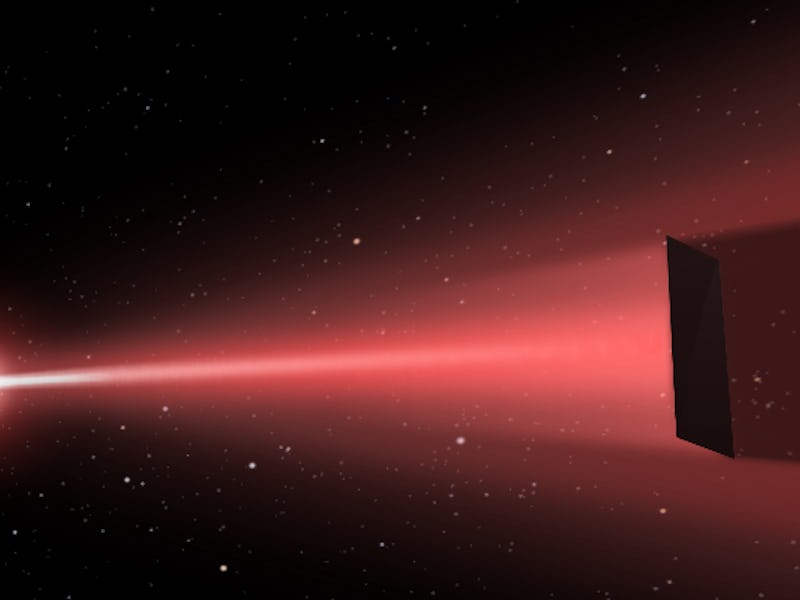The Starshot Breakthrough Light Beam Is Really a Million Lasers, Which Is Insane
If the pioneers behind Starshot Breakthrough get their way, Earth will become an innocuous Death Star.

The goal behind the $100 million Breakthrough Starshot initiative is to search Alpha Centauri (the closest star system to Earth, at just 4.37 light-years away) for habitable worlds and alien life. If you’re up on space science, then you know that’s a fairly logical extension of exoplanet research and in keeping with the scholarship surrounding the search for extraterrestrial life. What makes the Starshot initiative audacious is that it calls for spacecraft to travel over a trillion miles, sailing on a 100-gigawatt laser beam and lightsails. This bit is — to put it mildly — complicated.
There are many questions about how the Breakthrough Starshot team is going to pull the whole thing off and a lot of very interesting answers. But when it comes to the lightsails, the answers start getting pretty thin. The consensus in the scientific community is that of all the technological hurdles associated with the project, the creation of a powerful enough lightbeam is the most significant.
Milner and company want to build a kilometer-wide array of lasers (like thousands and thousands and thousands of them) at a high elevation and presumably in a desert. Then, when it’s time to push the nanocraft off to Alpha Centauri, they plan to flick a switch to shoot a 100-gigawatt beam that fires off the spacecraft at a fifth the speed of light. If that worked, our nanocrafts would hit the outskirts of Alpha Centauri within 20 years.
Seth Shostak, the director of the Center of SETI research at the SETI Institute, calls the “super-duper laser” an ambitious proposal, but also tells Inverse the idea has been out there for a while. Scientists have been considering laser-based propulsion methods for a while — most recently envisioning how such a system could get spacecraft to Mars in just three days’ time.
And yet, such an idea has never moved beyond the proposal stage, for a few reasons. One is cost. A single gigawatt can power 700,000 homes. That’s a lot of energy, and it doesn’t come cheaply. So imagine trying to power a 100-gigawatt system for 20 years. You don’t need to know anything about energy efficiency to know something like this — with current technology, anyways — will cost more than the GDP of entire nation states.
The other is power. NASA researcher Eduardo Bendek, who has studied Alpha Centauri for nearly his whole career and is working on a proposal to send a space telescope out to study the region, thinks the biggest issue behind Starshot is to figure out how to avoid “vaporizing the spacecraft” with the light beam. The nanocraft are just a few grams in mass. There’s an extremely high likelihood that firing a 100-gigawatt laser at them would cause them to evaporate. Bendek cites a previous experiment at Lawrence Livermore National Laboratory that began a thermonuclear reaction using a laser with a fraction of that power. “I don’t know how they’re going to figure this out,” he says.
Starshot has acknowledged this concern, but they haven’t released details on exactly how they’re going to build sturdy nanocraft. That might be because they have another, more pressing concern to figure out first — how exactly you’re going to get a light beam this powerful even made.
David Kipping, an astronomer at Columbia University, says that right now, we can only build individual lasers that max out at around one megawatt. How does he know? Kipping and a colleague of his recently wrote a paper which proposed building a laser-based system that could cloak the Earth from intelligent extraterrestrials looking for other lifeforms. Although the simplest cloaking device in that paper calls for something at just around 30 megawatts, power requirements still ran in excess to what a single laser to can do. A one-megawatt laser is at the edge of our engineering capacity at the moment, which means generating 100-gigawatts of power would require an array of one million lasers.
Shostak is quick to point out that with how quickly technology progresses, it’s not unthinkable that laser power could double every five years. In just 10 years time, a 100-gigawatt light beam could be produced with just a fourth of the lasers we might need today. That’s still a lot of damn lasers
Kipping’s proposal raised an alternative use for the major laser system: It would act as a beacon to help extraterrestrials find us. Something as massive as Starshot’s light beam could theoretically help us to cloak the planet, but pushing objects out into space would reveal our presence, he says. In addition, Kipping says the Starshot technology would probably result in what’s called “laser leakage” that cannot be contained. This excess light would act like a campfire radiating in the woods during the night. Even if the nanocraft couldn’t find anything in Alpha Centauri, Starshot could end up achieving its goal anyways by bringing aliens to us.
There’s obviously a lot of work that needs to go into the light beam proposal before we’re even close to seeing a small scale version of it being built. But Kipping emphasizes that the point isn’t to call anything impossible. “We shouldn’t snark at it despite the challenges,” he says. “Lasers will almost undoubtedly be an important part of how we conduct space travel and improve our lives here on Earth as well. I think it’s great we’re taking this idea seriously.”